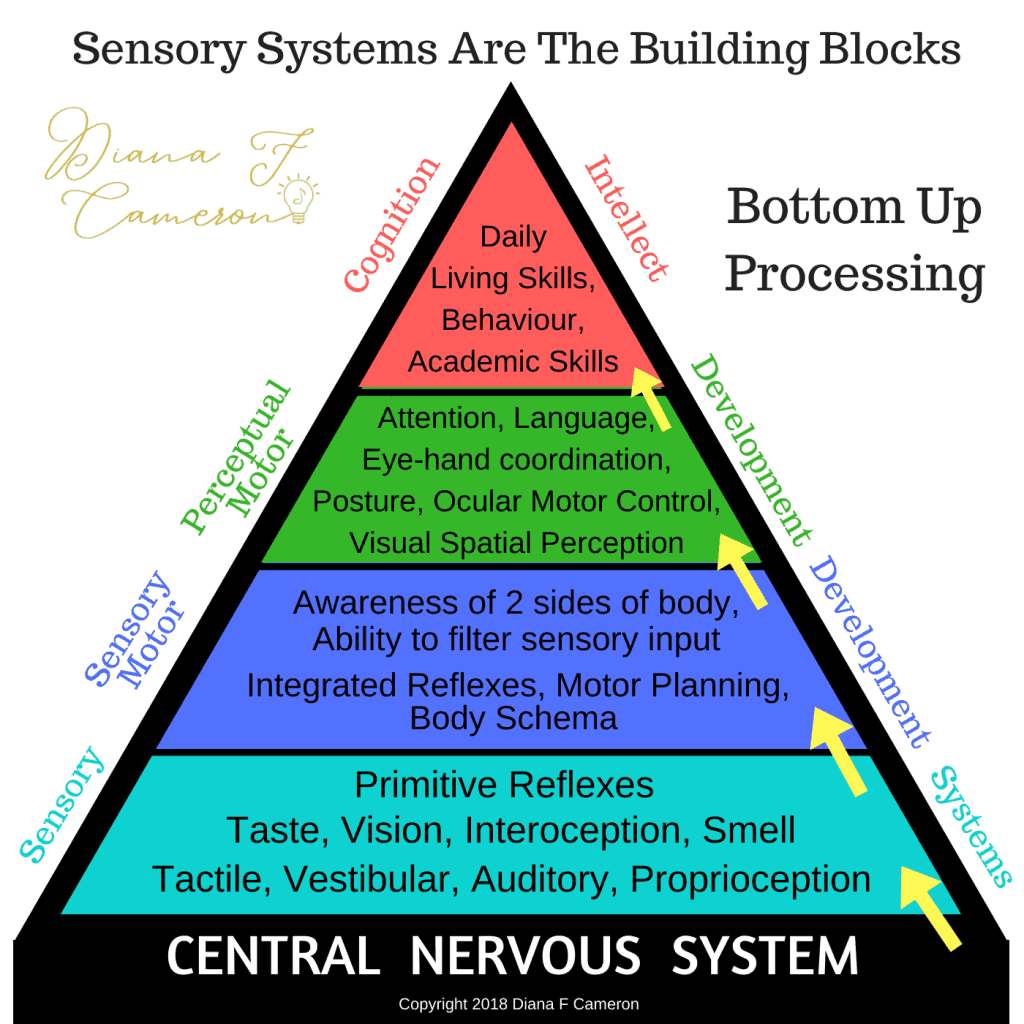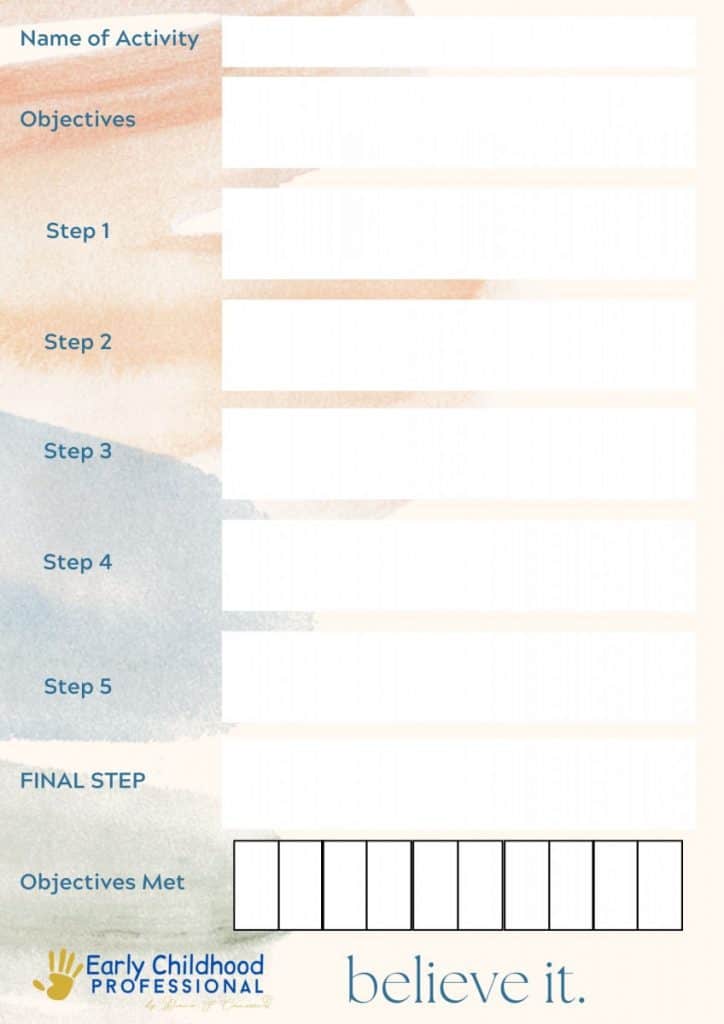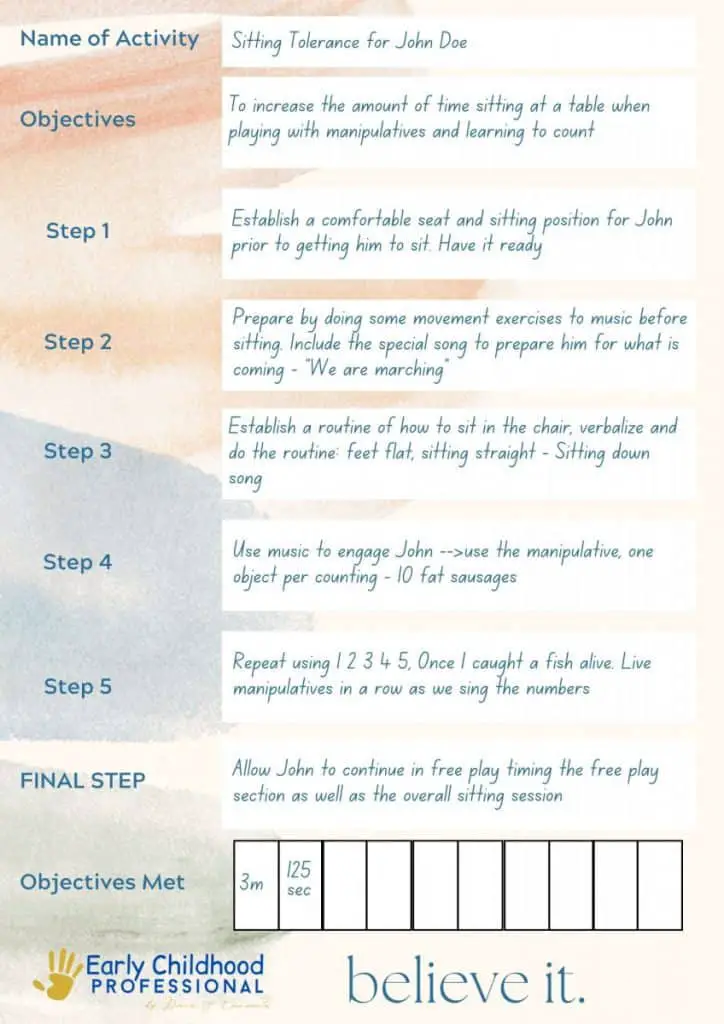Sitting tolerance is a thing. Some children have it, others struggle. So, what can you do to help develop sitting tolerance in the children you care for?
Several activities improve sitting behavior and sitting tolerance such as board games, rocking, yoga poses and sitting on a ball. Choosing the right activity depends on the contributing factor to poor sitting which could be attention span, vestibular function, sensory issues and/or core muscle strength. Sitting takes the highest form of balance and can be difficult for children with autism, ADHD and other sensory challenges.
Sitting Still Requires the Highest Form of Balance
While it might seem like the opposite, sitting still actually requires the highest form of balance. Think about riding a bike. It is much harder to balance on the bike when it is stationary than when it is moving.
Soldiers in the military who need to stand perfectly still at attention for extended periods of time will wiggle their toes in their boots to help them be able to balance and continue standing still.
If a child doesn’t have good balance, then they are not going to be able to sit still. They will be the children who move during story time, are constantly moving their bodies, or a part of their bodies, or poking someone next to them.
Some educators may think they are being “naughty” but in truth, they have figured out that their body needs to move to balance.
Vestibular Input – The Basis of Balance
One of the most important senses is the vestibular. It is the first system that all sensory input hits and it is the commander and chief that decides where it goes after that. If vestibular dysfunction exists, then sitting still is going to be a huge challenge.
Balance relies on vestibular input not only from the muscles but from the visual and auditory systems. Sitting still takes the highest form of balance – much more than moving. While it seems the opposite, the brain and vestibular systems are working harder than ever to make sitting or standing still possible.

Low Sitting Tolerance can be a Sensory Issue
Poor sitting tolerance in children can stem from several things, one of them being sensory issues. Young children are sensory creatures and interpret the world using all their senses. These are the building blocks for all other learning, including higher brain function.

Sensory Issues – Starting at the Beginning
As you can see, the senses (and we have more than you probably realize) are the building blocks of everything else. The balance, core muscle strength and focus needed for prolonged sitting are higher level functions, so if there are sensory compromises, there will be challenges.
Before anything happens, children with sensory issues need to be as calm as possible. They are already working with a deficit and are either sensory seeking or on sensory overload. If you want a child to sit with sensory issues, they need to calm the system first. Doing calm activities, singing songs, listening to music etc provides a way for the sensory system to calm itself and be ready for the challenge of sitting still.
Other Skills are Needed for Good Sitting Behavior
There are 4 other skills that are needed for children to have good sitting behavior. They are:
- paying attention
- following instructions
- retaining information
- reproducing information
- manipulating objects
For these things to happen, a child must be able to have good sensory input through both the body (vestibular and proprioceptive senses) and the auditory system.
If children are not processing sound correctly, all four of the above skills will be impacted. Sitting still and concentrating will be difficult because their brain will be preoccupied trying to keep up just processing what was said, let alone putting it all together and formulating a response.
If they also have poor vestibular processing (which often goes hand in hand with poor auditory processing) then you will end up with a child that is fidgety, not focused and has poor sitting tolerance.

How Can I Improve Sitting Tolerance in a Child with Autism?
For children with autism, sitting behavior can be affected by vestibular and sensory issues so determining the cause is imperative to choosing the correct remedial activity. Being able to sit still is a skill all children can become better at, even those with neurological challenges such as autism.
Children with autism though, may have other challenges that go hand in hand with autism such as auditory processing disorder, sensory challenges, and vestibular dysfunction.
Take into consideration these things when practicing sitting tolerance:
- Choose something they are interested in. Your child will have an easier time concentrating for longer on something they find interesting than things they struggle with. Be aware of those things that your child gravitates towards and see if you can use one of them to practice better sitting behavior.
- Have a distraction free environment. According to a study on autism in 2020, the parts of the brain that control attention in children with autism have atypical activity that was reflected in “exaggerated and variable responses to sensory stimuli”. In other words, children with autism are far more easily distracted than children without and have difficulty attending to specific information. Providing an environment that is as free from distractions as possible will help.
- Use sensory aids where necessary. Many children with autism have sensory issues. They can be uncomfortable in certain clothing or touching certain textures. Choice of seat is especially important. There are sensory seats available in a variety of types, sizes and textures. CLICK HERE to see some.
- Use fidget toys if sitting still and concentrating. Fidget toys are fantastic for kids who always need to be moving. If they need to sit still (and not use their hands) fidget toys can be a great way to allow their body the movement it needs, without distracting others. They come in a wide variety of types, are usually colorful and keep wandering hands busy.

How Can I Improve Sitting Tolerance in a Child with ADHD?
Children with ADHD have to calm the central nervous system before working on sitting tolerance. This can include things like singing songs and listening to music.
Preparation is really important for children with ADHD. Their sensory systems are already heightened so to get the maximum effect out of activities to help improve sitting behavior, there needs to be some preparation to calm the CNS first.
Calming Activities in Preparation for Sitting Tolerance Activities
- Singing songs – singing has many benefits but one of them is stress relief. The act of singing provides an avenue to de-stress the brain and body and is an excellent foundation for upcoming more challenging activities
- Listening to music – this has huge benefits if it is done consistently, every day. The central nervous system doesn’t know how to release and with kids with ADHD, they often can’t self-calm. Learning to calm ourselves on cue is a learned state and for these kids, one that needs more attention than neurotypically developing children. It can be as simple as putting on a piece of music once a day and stopping activity and just listening. As most children with ADHD will need to move, have them concentrate on their breathing and count. The following breathing exercises can be done while listening to music or just on their own.
- Breathing activities – controlled breathing helps the body and brain to calm but for children with ADHD it will need to have structure to it and something to concentrate on. By counting the breaths, it gives them a focal point and helps their brain to tune into one thing, rather than being scattered and all over the place. Here are some examples:
- Breathe in for 2 and out for 4 – controlled breaths.

2. Breathe in for 4 and out for 4 counts

3. Cover the right nostril and breathe in through the left nostril. Then cover the left nostril and breathe out through the right nostril.

After any of the preparation activities have been completed, move onto the more challenging activities below to strength sitting tolerance.
We Need to Have Realistic Expectations
Firstly, we need to make sure we have realistic expectations as to what we are trying to achieve, and what is appropriate for the age of the children we are working with.
The younger the child, the shorter the amount of time we would expect them to be able to sit for, and if there are additional challenges, then that time will be further shortened.
Knowing what would be considered appropriate for neurotypically developing children is important and also remembering that this is a skill that will happen in stages. A child won’t go from not being able to sit well to achieving the optimum goal overnight.
Tolerance needs to be built slowly, and all increases need to be celebrated as successful, no matter how small they might seem.
Average Times we Would Expect Neurotypically Developing Children to Sit:
| Age of Child | Amount of Time |
| 8 – 15 months old | 1 – 2 minutes |
| 16 – 19 months | 2 – 3 minutes |
| 20 – 24 months | 3 – 5 minutes |
| 2 – 3 year olds | 5 – 8 minutes |
| 3 – 4 year olds | 8 – 10 minutes |
| 5 year olds | 12 – 15 minutes |
| 7 year olds | 25 minutes |
| 10 year olds | 40 minutes |
Keep in mind that some children will be able to sit longer than these times and some shorter, but they are averages to give you some idea if your expectations are realistic.
Questions to Ask About Kids with Limited Sitting Tolerance
There are some questions that you can ask to narrow down contributing causes that, when addressed, may help alleviate some of the sitting challenges.
These questions are:
- How long are you expecting them to sit?
- Are they looking for attention?
- Have they had enough time for physical activity and stimulation?
- Are they comfortable when sitting? Can you make them more comfortable?
- Have you set clear boundaries and expectations?
- Have you implemented a reasonable process?
How Long are You Expecting Them to Sit?
As previously mentioned, our expectations must be realistic, considering any other contributing factors that may make sitting tolerance especially difficult. Autism, ADHD, sensory issues, vestibular dysfunction, self-regulation difficulties, inability to focus and other challenges can make children intolerant to sitting.
First, assess how long the child can sit for, then set a realistic goal and aim to increase slowly. Even a gain of 10 seconds is progress and should be celebrated.
It is also important to remember that the trajectory of change is not a straight line, but there will be good days and bad days. As long as there is a positive trend overall as you move forward, that is a gain.

Are They Looking for Attention?
Sometimes, children’s needs are not being met and it isn’t a case of sitting tolerance but that they are looking for attention. It is important to rule out this possibility, so you know you are dealing with other issues that contribute to sitting intolerance.
Have They had Enough Time in Physical Activities?
Vestibular input through physical movement will not only help with sitting tolerance, but it improves balance which is vital in good sitting behavior.
Children who struggle with sitting need more vestibular input and physical activities and play than other children, not less. By making them sit longer, taking away from physical activity time, results in the opposite of what you are trying to achieve.
Allow children more physical play, especially just prior to required sitting tasks. This preps the body’s vestibular system and will help with the required balance needed to sit still.
Are they Comfortable?
Being uncomfortable might sound simple, but for some children, sitting in a chair is incredibly uncomfortable.
For some it is the chair itself. They need wedges or Sensory Seats to help them feel comfortable.
They may even need something different from a chair altogether, like a study done in August 2020 found that “hemodynamic changes occur with a position shift from supine to sitting in children and adolescents; those with remarkable changes are accompanied by sitting intolerance symptoms.” In other words, those children with significant heart rate and blood pressure changes from changes in position (sitting standing and lying down) had sitting tolerance.
This can cause symptoms such as dizziness, headache, palpitations, chest tightness, nausea, and sweating.
If this is always how a child has felt and it has been undiagnosed, then sitting will always been uncomfortable for them. Using keen observation skills to ascertain whether these may be contributing factors will help to determine causes and provide additional avenues for solutions.

Have You Set Clear Boundaries and Expectations?
It is well known that children are most emotionally secure when they have boundaries and are very clear about what the expectations are. If we know what we want but don’t communicate that effectively so the child can understand those expectations, the results won’t match our predictions.
We need to limit our instructions to one or two things at a time and build success for those things first. While they may not be the whole of what we want to achieve, they are a steppingstone in the right direction.
Process: The Way to Achieve Desired Outcomes
A great way to map out and assess if desired outcomes are being reached is to work out a process.

There are some essential steps when using process. These are:
- Start with the end in mind and work backwards
- Work out every step that the child needs to complete to complete the overall task.
- Work out a timeframe for each step and the project as a whole
- Include repetition
- Keep a record of outcomes so you can compare over time.
Click on the images below to download the form that you can use for developing your process. You may not need all 6 steps but fill out what you do need and then there is a place to track if your expectations have been met, or you could record the amount of time they were able to sit for.
There is also an example of one filled out.
What Activities Will Strengthen Sitting Tolerance?
Children who wiggle and jiggle and just can’t sit still may be struggling with different challenges. It is important to find out what is the cause (or causes) of their sitting tolerance issues and use activities to strengthen those weaknesses.
The following sitting tolerance activities are divided into three sections, each addressing a specific area of difficulty:
Finding the primary cause and addressing that first will help you to see if any other exercises need to be used.
Sitting Activities for Vestibular Challenges
- Rocking – While you might not see the correlation between rocking and sitting still, rocking is a great activity for stimulating the vestibular system. There are 3 semicircular canals in the vestibular system and if you rock 3 ways, you can stimulate each one. Forwards and back, side to side and in a circular motion. In a seated position, this allows the child to balance more easily, strengthens the vestibular system and allows a greater chance at success for sitting still. If you have a child who is struggling with prolonged sitting times, have breaks with movement or rocking in between.
- Wedge or Sensory Seat – Providing a wedge gives a different vestibular input. If you are worried about the child sitting on a ball and wiggling around, put them on a foam wedge instead. The gradient engages the vestibular senses, providing the necessary input and challenges to aid in balance, making sitting still easier.

Sitting Activities for Concentration Span/Attention:
How Long Can They Sit?
Sequencing is a huge part of focusing. Focusing is needed for sitting tolerance. In addition to these, concentration and attention span are all things needed for sitting still. A child may have good vestibular function but struggle with sitting for periods of time because of a poor ability to concentrate. These are specific activities you can do to help these areas:
- Board Games – These require attention span, concentration and assist in developing positive sitting behaviors. While there is some movement required in moving objects on a board, most of the time is spent sitting still and concentrating on the game until their turn comes around. Some board games take longer than others, so initially, choose something that is short lived, and they can accomplish quickly. Then slowly extend the time with more complicated games.
- Craft Activities – Something they are interested in requires attention to detail in addition to other fine motor skills. Craft is a wonderful way to encourage sitting tolerance and concentration. It also addresses sequencing, with having to create a plan, work out how to implement that plan and then create the craft. The more practice they have, the better the sequencing and concentration skills become.
- Pick and Fill – Sit at a table with water beads in a container. Have the child pick marbles one by one and fill a 2-liter bottle. Because the water beads just fit in the mouth of the bottle it takes time, fine motor control and concentration to make it work. Children love this activity which also provides tactile stimulation with the structure of the water bead. Brightly colored and squishy, kids love filling the bottle and watching them drop through the neck hole.
- Extended Exhale Activities – Children who have more difficult attending and focusing often breathe more inefficiently or in a shallow way. Activities that require more extended exhale of breath and improve respiratory function include bubbles, kazoos, recorders, and Blo-Pens. By using controlled breath with deeper, longer respiratory function, children develop better concentration and control. This also helps with the control needed for positive sitting behaviors.
- Sitting Position – where are their feet? Sometimes children find it extremely uncomfortable to sit in a chair with their legs dangling in the air. Their legs swing which can be an invitation for them to swing and kick, looking for contact with something, providing an additional distraction. This can be because of low core strength, vestibular challenges or because they don’t feel secure. Try having their feet either on the ground (a chair short enough for that to happen) or use a stool so their feet can rest on that.

Sitting Activities for Core Muscle Strength
Another issue that can cause issues with sitting tolerance is lack of strength in core muscles. As the torso is needed to support the head and upper body, children with poor muscle strength will struggle with sitting. Here are some activities that can help with core muscle strength:
- Wheelbarrow Walks – Popular amongst children where one child is on the ground on all fours and another child picks them up by their feet and they move around the room with the child on the floor supporting themselves on their arms. This forces the core muscles to engage and strengthen (as well as the arms and upper body).
- Crab Walking – Sitting on the ground, with arms behind, the child raises themselves up off the ground on legs and arms (back facing the ground) and move sideways like a crab. The core muscles must engage to support the body which aids in strengthening both core and upper body.
- Yoga Poses – There are several yoga poses that you can do with your children to help build core muscles. From making bridges to superman, there are many poses that children can do to build core strength. Find some specifics here: https://theinspiredtreehouse.com/child-development-core-strengthening-for-kids/
This goes for children who sit for any length of time but especially for children who struggle – make sure you have breaks and opportunities for movement and vestibular input in between sitting sessions. This could be movement, massage, jumping, or even some yoga poses together. You will find that over time, children will be able to sit for longer periods and concentrate more easily.
Preparation is important (calming the sensory system) and having a plan for scheduled breaks with movement. This helps concentration, sitting behaviors and the ability to focus when required to sit still.
Without these breaks, children can suffer from fatigue (which can also result from any of the other issues). Fatigue will come more quickly to those children who struggle with balance and concentration and will make sitting still uncomfortable and difficult.
With planned activities to help strengthen and engage children, you will have more productive floor time activities.


